How to Select and Optimize Images for Your Website
Creating effective visuals is essential to the success of any website. Optimize Images can help draw in visitors, convey information quickly and easily, and add an extra layer of interest to a page or article.
But selecting and optimizing the right images for your website takes time and thought. In this article, we’ll discuss how to select the most appropriate images for your website and how to optimize them for maximum impact.
We’ll also explore some common mistakes you should avoid when choosing visuals for your digital content. By following these tips, you’ll be able to make sure that your website looks great with engaging visuals that are optimized for maximum effect.
Locate Free Images
When looking for visuals to add to your website, you’ll want to look for images that are both high quality and free.
There are several websites with large collections of free stock photos that can be used on any website without worrying about copyright infringement. Some popular sources of free images include Unsplash and Pexels.

Optimize Images
Optimize Images for Web
Once you have chosen the appropriate image for your website, you will need to optimize it for web use. This means reducing the size of large images and saving them in a format such as JPEG or PNG.
You should also consider compressing the file further to reduce its size even more, while still maintaining good quality.
Additionally, consider adding a descriptive alt-text to the image, which is what search engines use to understand the content of an image. This can help with your website’s SEO and make sure that your images are properly indexed.
Choose Compelling Images
You should choose visually compelling images when adding visuals to your website. Try to pick images that grab people’s attention and draw them into the content of a page or article. You want visitors to be drawn in by the visuals and compelled to read more about what you have to say.
By following these guidelines for selecting and optimizing visuals for web content, you can ensure that your website looks great with effective visuals that add interest and engagement for visitors.
With compelling visuals in place, you will be able to effectively communicate with your website’s visitors and create a great user experience.
Name Your Images Properly
Finally, make sure to name your image files appropriately. This helps to identify the image later on and makes it easier for search engines to find and index them.
Try not to use generic file names like “image1” or “photo2” because these won’t provide any information about the content of the file. Instead, opt for meaningful names that describe what is in the image such as “sunset-at-the-beach” or “blueberry-pie”.
By taking all of these steps before adding visuals to your website, you can ensure that you are getting the most out of your images and creating a great user experience for visitors.
Contact Us for SEO Support
If you need help optimizing your visuals for web content or want to get more advice on how to maximize the impact of your images, contact us today.
We can provide detailed guidance and assistance with selecting and optimizing visuals as well as improving your website’s overall SEO performance. With our expert support, you can make sure that your website looks great and attracts more visitors.




